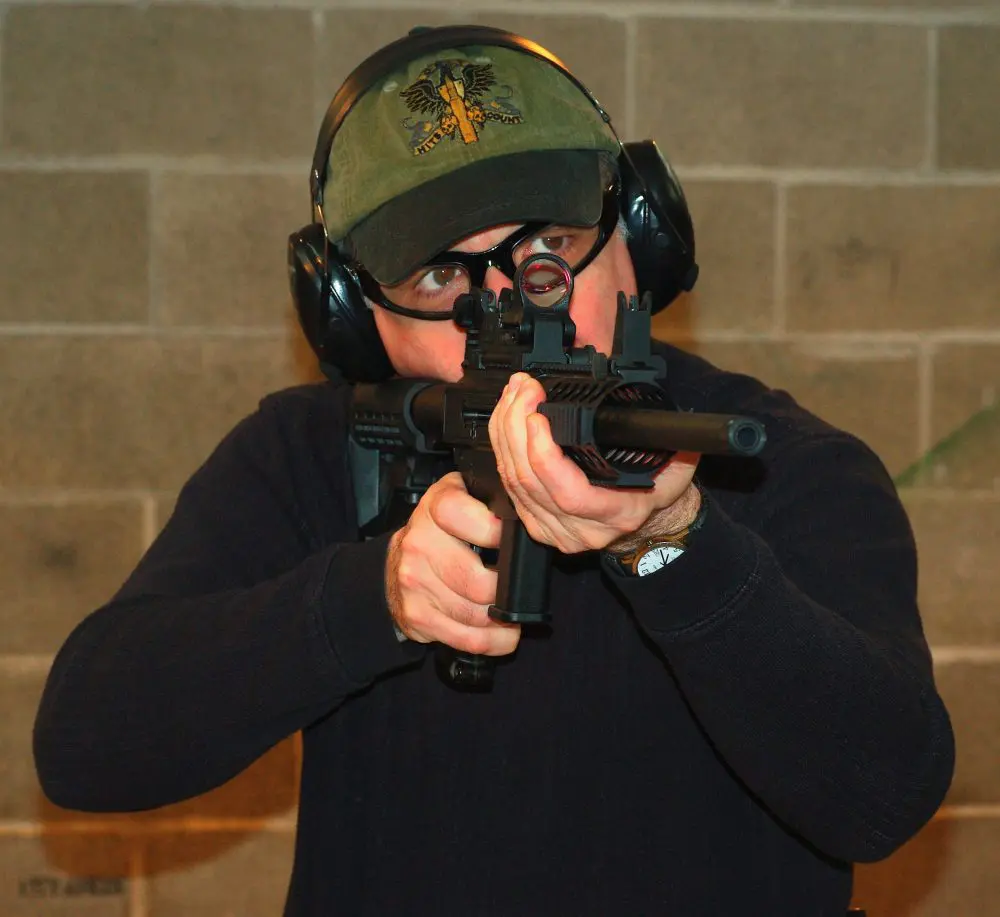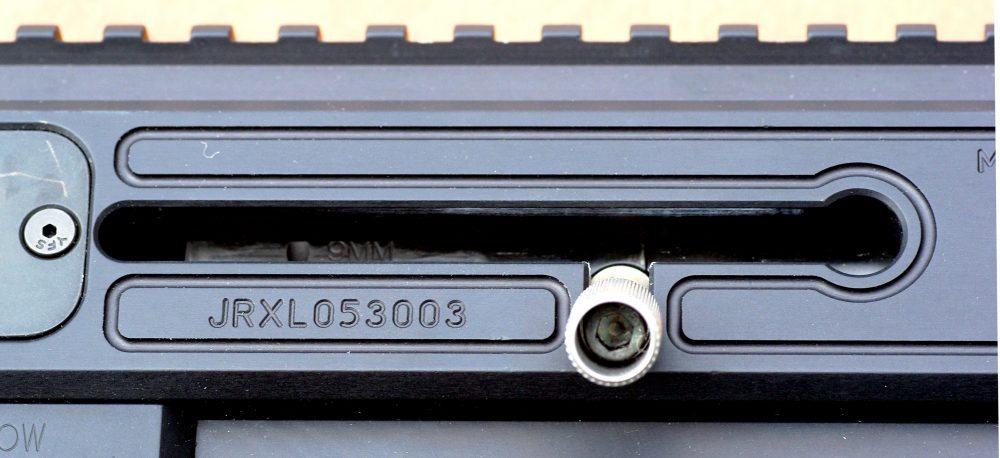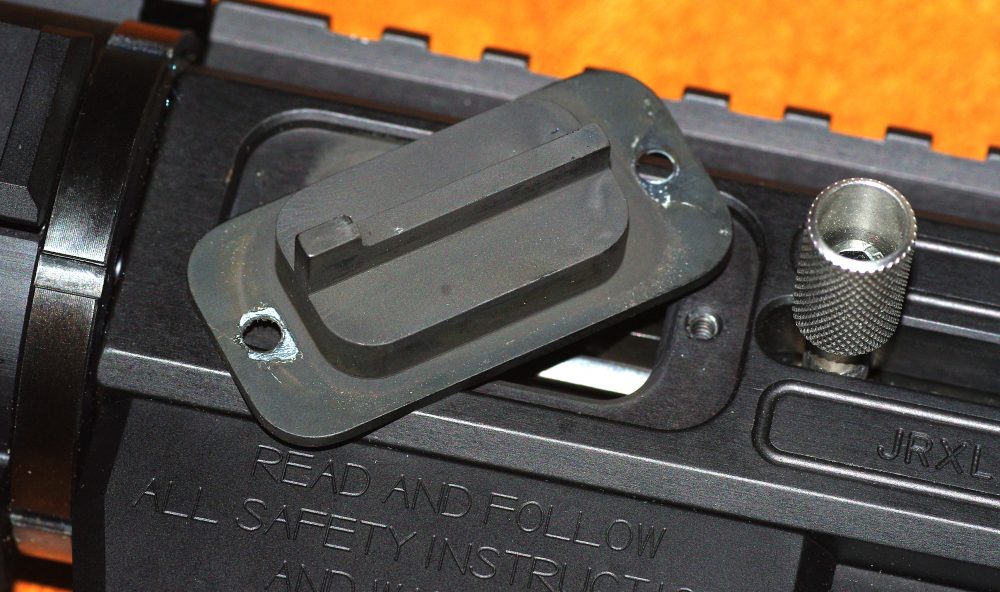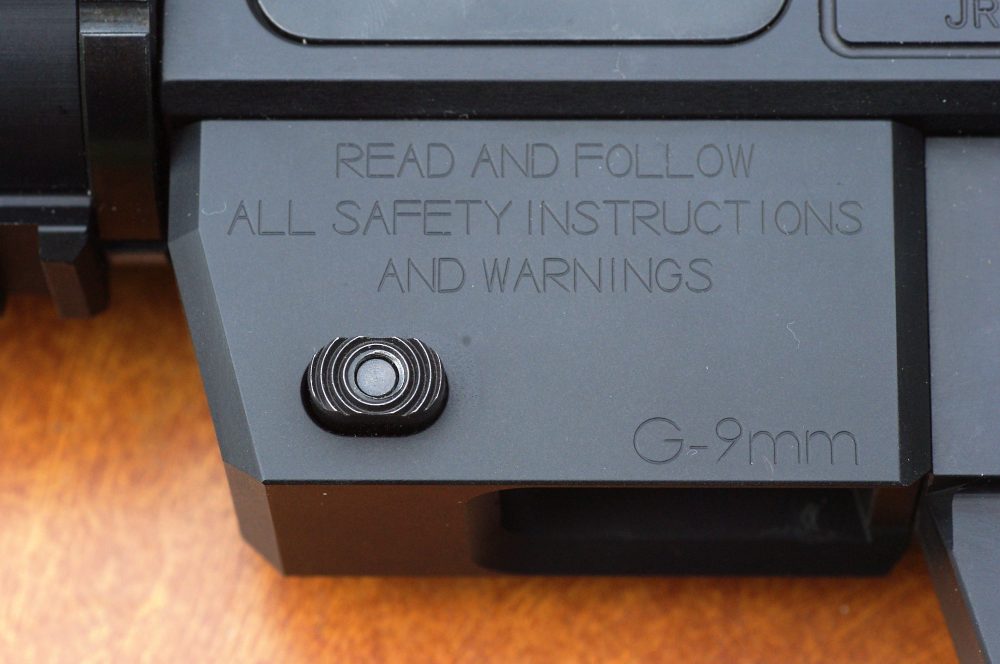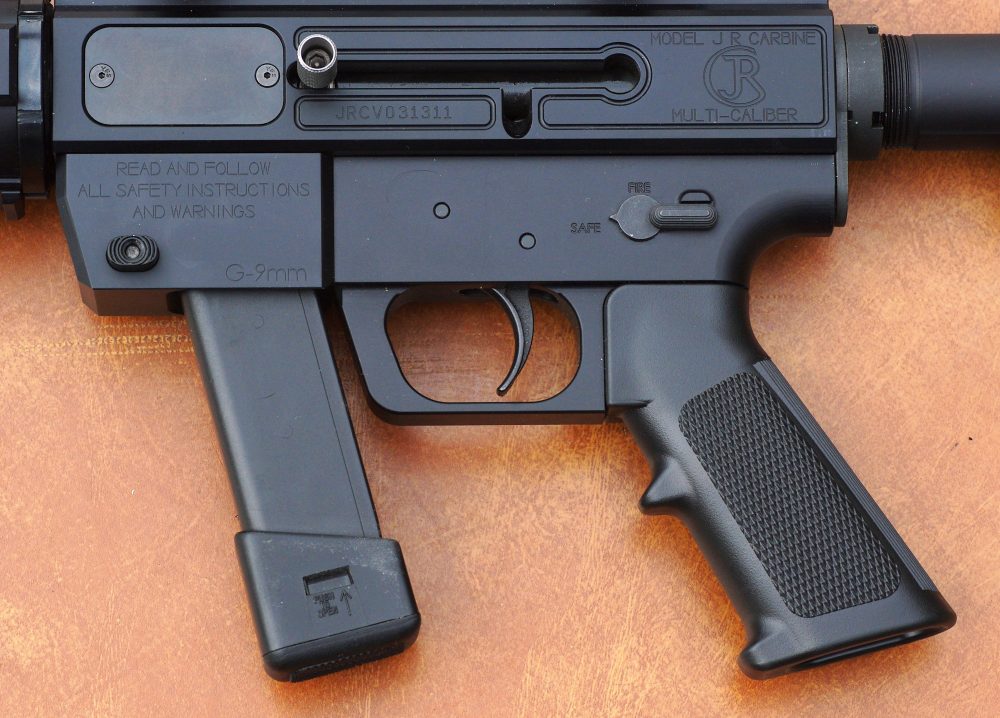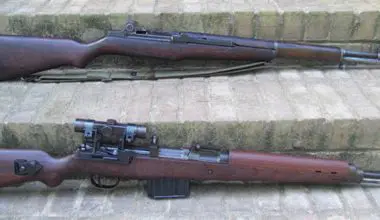The Just Right Carbine (JRC) is a pistol-caliber carbine set up to be easily retrofitted with a variety of AR-15 aftermarket parts, feeding off any Glock magazine in 9mm, .40 S&W or .45 ACP. Recently Just Right introduced a model in .45 ACP using 1911 magazines, and also in 9mm and .40 S&W with Smith & Wesson M&P mags. My sample JRC was the Glock 9mm version.
Author on range with Just Right Carbine. Thomas found it very easy to shoot fast and well.
Table of Contents
PURPOSE
The first thing I think of when the topic of the semiautomatic pistol-caliber carbine comes up is home defense. Especially in 9mm, such a gun has light recoil and overall handling qualities so mild-mannered that even lesser-trained folks can shoot it decently, and well-trained people superbly.
Years ago Ed Sanow took a sound meter to the range with numerous handguns, chambered for a variety of cartridges, and measured how much noise they generated. Among auto-pistols in serious calibers it was no contest: the 9mm was by far the least potentially injurious to your hearing. This is hugely important when firing indoors without hearing protection.
Also the 9mm out of a long-barreled carbine has little muzzle flash, especially in this era of flash-retardant powders, so there’s not much of a fireball to dazzle eyes dilated wide in low light.
However there is one thing to be very careful about regarding the 9mm-carbine-as-home-defense-weapon concept: overpenetration.
The 9mm Parabellum with conventional ammunition is a deep diggin’ terror in normal building materials. However, this can be controlled by choosing only ammunition designed to break up on building materials in the event of a missed shot.
Just Right Carbine has some parts commonality with AR-15s.
PISTOL-CALIBER CARBINE/HANDGUN COMBO
The idea of having your long gun and handgun chambered for the same cartridge is an old one, most famously prevalent in the Old West. I think the fact that the JRC feeds off Glock/1911/M&P mags is a very good thing.
These days, we ideally want to carry the same magazines in our rifles and pistols. You could carry a JRC and a Glock/1911/M&P and feed both guns off the magazines on your belt versus having to carry two different sets of magazines containing two different cartridges with the attendant bulk and weight.
Just Right Carbine is chambered for pistol cartridges and intended to be convertible among cartridges. In actuality, this is easier said than done.
JUST RIGHT CARBINE SPECS
The barrel on the Just Right Carbine is 17 inches long, made of 4140 steel, with a 1:16 button-rifled right-hand twist, and is pre-threaded to take a flash hider or suppressor. Since neither is supplied with the carbine out of the box, the threads are covered with a screw-on barrel cap.
The upper and lower receivers and magazine well (a separate part) are all machined from 6061-T6 aluminum with a black anodized finish. Out of the box with no optics installed and an empty magazine in place, the test sample weighs 7 pounds, 3.2 ounces, similar to a 16-inch barreled AR-15.
The JRC may be switched between any caliber in which it’s available, provided you have not only the requisite replacement parts such as the barrel, bolt, and (possibly) magazine well, ejection port cover/ejector, and buffer (depending on which calibers you’re switching between), but also an AR-15-compatible barrel nut wrench, forend wrench, castle nut/buffer tube wrench, three different hex wrenches, a padded bench vise, and a reasonably advanced level of gunsmithing skills.
Barrel is threaded to accept a flash hider or suppressor. Out of the box, the threads are protected by a steel muzzle cap.
So while this is a nice feature on a theoretical level, it’s also a complex, time-consuming process and I can’t imagine very many people actually ever wanting to do it.
Along the top of the upper receiver is a built-in Picatinny rail feeding into a forend quad rail. Unfortunately the forend on the JRC has more sharp edges on it than I’m used to seeing on a quad rail. I can in no way describe it as “comfortable.”
Fortunately this forend can be replaced by any aftermarket AR-15 forend. In my opinion, this is a non-negotiable necessity. But replacing the forend may also require replacing the barrel nut and the locking ring retaining the forend, depending on if what’s already on the rifle is compatible with the new forend.
Bolt may be manually locked to the rear by aligning bolt handle with vertical leg of the “T” and rotating it down.
MAGAZINE RELEASE BUTTON
While the JRC mimics an AR-15 control layout in some other areas, the magazine release button is not one of them. Instead of being set up on the right side of the rifle to be manipulated by the shooting-hand index finger, the JRC’s mag release is located at the front left of the magazine housing. This is bad for several reasons.
The mag button is very exposed, as there are no “fences” around it to shield it like on an AR-15. Its spring is quite light. Simply handling the gun in an administrative fashion, as well as several times during live fire on the range, I accidentally depressed the magazine release, dumping the mag out of the rifle.
If you shoot with the technique of wrapping your support hand around the forend/receiver junction and pulling back, this can also depress the magazine release button. Several times, given the mag button’s very exposed state, the magazine accidentally ejected simply by being brushed against an object.
Ejection port on JRC is an open “rounded rectangle” window. There is no dust cover.
REVERSIBLE BOLT HANDLE
The bolt handle is reversible from one side of the carbine to the other. Since when manipulating the bolt handle, I prefer to keep my right hand on the pistol grip and cycle the bolt with my left hand while leaving the rifle shouldered, I set up the sample JRC’s bolt handle on the left side.
When reversing the bolt handle, I inserted the bit from my Brownells Magna-Tip Super Set Plus screwdriver kit in front of the bolt, crossways across the upper receiver inside the front of the bolt track. This held the bolt to the rear the exact distance necessary to allow the interior flanged portion of the bolt handle to be removed from the “wide” portion of the bolt track. Then I could withdraw the bolt handle.
Once the bolt was held to the rear, it took about a minute to remove the screw holding the bolt handle in place, extract the handle from the carbine, move it over to the other side, insert it into the track there, then reinstall and tighten down the screw.
On both sides of the carbine is a T-shaped track in which the bolt handle reciprocates during cycling. To manually lock the bolt to the rear, pull the bolt handle back until it’s even with the downward leg of the “T” and rotate it down into the slot.
Ejection-port cover plate incorporates carbine’s ejector. Switching plate over to opposite side changes its ejection pattern.
EJECTION PATTERN
The JRC can be configured for right- or left-hand ejection. Part of the procedure for switching over the ejection pattern requires disassembling the rifle with tools, punching out a cross-pin retaining the bolt’s extractor, then switching it over to the other side of the bolt and reinstalling the pin before reassembly.
As it comes out of the box, the ejection port is an open “rounded rectangle” on the right side. On the left side of the carbine, in front of the bolt handle slot, is a flat steel plate, the exact same size and shape as the ejection port, held in place with two flat-top hex screws. In addition to covering over the unused “extra” ejection port, this plate incorporates the rifle’s ejector.
Switching over the ejection pattern also requires moving this part from one side of the rifle to the other, covering over the right-side ejection port and simultaneously opening up the left-side ejection port.
I would like to see this carbine incorporate a spring-loaded dust cover instead of leaving the ejection port completely open. While arguably not really important for home defense, a dust cover would certainly be one thing that could elevate the JRC from “interesting curiosity” to “serious weapon.”
Magazine release on JRC is unshielded in any fashion and placed at front left of mag-well housing.
OTHER COMPONENTS
There is no automatic bolt hold-open when the carbine is shot dry. The bolt simply follows forward onto an empty chamber. While there have been very successful weapon designs that do not feature a bolt hold-open, I like my gun to tell me when it’s empty by locking its bolt/slide to the rear. When the gun goes dry, it makes things much easier and faster to simply insert a fresh mag and hit an external bolt release.
The thumb safety is of the pattern familiar to anyone who’s ever shot an AR-15. On my own AR-15s, I prefer a crisply operating thumb safety where I begin rotating the lever with my thumb, and as it gets about halfway around, it snaps the rest of the way over by itself. On the JRC, thumb safety operation is mushy. The lever must be manually pushed through the full 90 degrees to off-Safe.
Collapsible stock uses commercial-width receiver extension.
The trigger pull breaks at an even six pounds according to my NRA weight set. It’s a single-stage trigger, i.e., you feel resistance as soon as you put your finger on the trigger. The trigger stroke itself is quite long, about an eighth of an inch, with much creep and overtravel. Fortunately, in keeping with its design concept of being set up to accommodate AR-15 aftermarket parts, the JRC may be retrofitted with a drop-in trigger setup.
The pistol grip is the milspec A2 unit, with “finger bump” frontstrap. This can be replaced with one of the immense assortment of AR-15 pistol grips available.
The collapsible stock is the milspec-pattern slider. Many shooters will upgrade to something else. And again, since the JRC is set up to work with AR-15 parts in the area of the stock, it’s easily accomplished. The receiver extension (buffer) tube is of commercial circumference.
Thomas fitted JRC with a C-More Railway Sight, which combines a fully adjustable rear aperture sight with a red dot.
MAGAZINES
My sample JRC came equipped with two 15-round Glock 19 mags. I was a bit surprised by that, because I’d expected 17-round Glock 17 mags. However, experimenting with my own magazines with the sample rifle disclosed some interesting facts about how various sorts of mags interact with the JRC.
I found fully loaded Glock 17 magazines difficult to snap into the carbine with the bolt forward. A committed whack of the hand was required. Forget doing speedloads with fully loaded Glock 17 mags.
If you want to use Glock 17 magazines, in order to insert them into the rifle with the bolt forward when empty (almost certainly what you’d be doing in a critical situation since there is no bolt hold-open), you need to download your Glock 17 magazines by one round to free up some spring compression and make them insert more easily.
By contrast, the 15 rounders inserted easily into place, even when brand new. When the springs wear in a bit, that will become even easier.
The JRC was picky about which magazines it would and wouldn’t drop when hitting the magazine release button. If this were my carbine, I would test my magazine supply to find out which ones will drop free, and earmark those for use in this gun.
JRC came equipped with two 15-round Glock 19 magazines. When snapped into the rifle, this is a very low-key and out-of-the-way setup.
A shooter could get down really low in the prone position with the “stock” magazine in place. However, a trick many AR-15 shooters use from prone is to rest the bottom of the mag on the deck as a monopod. The most interesting Glock 9mm magazine for use in the JRC was a Glock 17 mag fitted with an Arredondo +5 extension. This gives you 22 rounds of 9mm in a Glock magazine. The end of the magazine comes down almost exactly as far as the end of the pistol grip and could be used as a monopod from prone.
The magazine that everyone mentioned to me when I told them about the JRC was the 33-rounder originally designed for the Glock 18 machine pistol. I test fired the JRC 9mm with the two supplied 15-round mags, the 22-round Arredondo extension set-up, and the 33-rounder, all of them fully topped off with a round in the chamber, with Black Hills 115-grain Tac-XP +P hollow points, and it worked perfectly with every mag.
Seventeen-round Glock 17 magazine fitted with Arredondo +5 extension gives 22 rounds of 9mm in the mag.
RANGE EVALUATION
For test purposes, I attached a C-More Railway sight to the carbine, which incorporates a fully adjustable AR-15 rear iron sight assembly into the same unit as a red dot. A bolt-on adjustable front sight assembly completed the BUIS setup.
At the 50-foot indoor range on which I do most of my shooting, the BUIS was quickly and easily brought to point of impact/point of aim. Setting up the C-More for minute-of-chest at seven yards, appropriate for a home-defense rifle, was likewise easily and swiftly accomplished.
I ran the JRC through a series of speed shooting drills, including double tapping a single target, transitioning among multiple targets, speedloading, and coming up from a ready position. As you would expect from a red-dot-equipped 9mm carbine, it was easy to shoot fast and well.
SUMMARY
The Just Right Carbine has some great attributes: the ability to take AR-15 aftermarket parts, a Picatinny rail along the top, a quad rail so you can bolt anything your heart desires onto the front of the gun, the very well-placed and easily operable AR-15 thumb safety, a collapsible stock, a level of ambidexterity in its reversible bolt handle and ejection pattern, and feeding off very common and easily available pistol magazines.
Unfortunately, in my opinion, the lack of a bolt hold-open when empty, a complex field-stripping procedure that requires tools to execute, and especially a poorly designed and placed magazine release button, remove it from contention as a serious weapon.
I would like to see those shortcomings addressed, at which time the JRC would reach its full potential.
SOURCES:
Just Right Carbines
(585) 396-1551
www.justrightcarbines.com
Black Hills Ammunition
(605) 348-5150
www.black-hills.com
Brownells Inc.
(800) 741-0015
www.brownells.com
C-More Systems
(540) 347-4683
www.cmore.com
